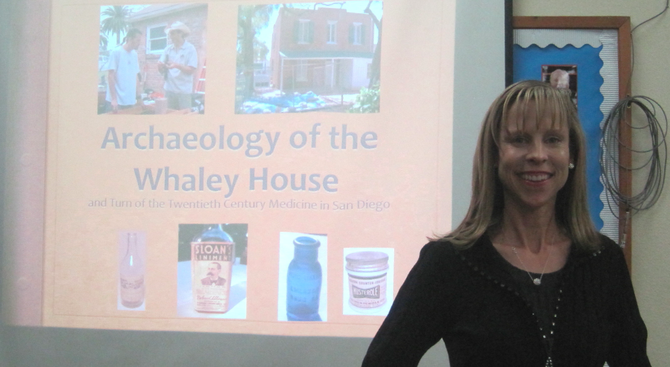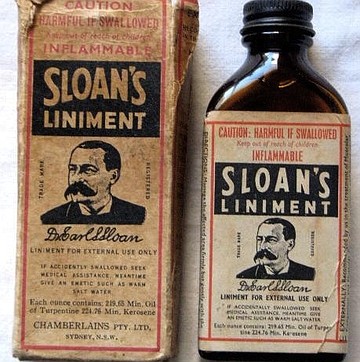 Facebook
Facebook
 X
X
 Instagram
Instagram
 TikTok
TikTok
 Youtube
Youtube

Based on a study of the bottles found during the archaeological excavation of an Old Town home built in 1857, prescription drugs accounted for much of the medications used by the Whaley family.
The Whaley House was one of five local archaeological sites that SDSU archaeology graduate student Kathy Collins researched for her thesis, “Archaeology at the Whaley House and Turn of the Twentieth Century Medicine." Collins discussed her research at the February 21 Friends of Lake Murray meeting at St. Dunstan's Episcopal Church.
Collins said she was interested in how illness was treated during the American Victorian era in San Diego, a subject that she examined by studying archaeological finds at the Whaley House and four other sites.
Her cross-site comparison also included the Theosophical Society site in Point Loma (now the location of Point Loma Nazarene University), the Palomar Mountain home of freed slave Nate Harrison, and two downtown locations.
The Chinese-American dig focused on a merchant's shop and a boarding house where Chinese laborers lived. The "melting pot" site involved excavating at the homes of four families: two Latino (Lopes and Azhocar) and two non-Latino (Meadows and Ramsey).

Collins said the wealthy Whaley family "could afford to go to the doctor" and opted more for prescribed medicine. The family, like many of the American Victorian era, also used patent medicine. That designation, said Collins, was "actually a misnomer, because there was no U.S. patent for medicines sold between 1860 and 1906. More than 50,000 patent medicines were sold," and "none listed ingredients." Those medicines could contain up to 100 percent alcohol mixed with herbs. Other ingredients including narcotics and opiates.
Collins said prescription medicine contained many of the same ingredients as patent medicines. These included herbs and narcotics. Medicines prescribed for women included laudanum, which Collins described as "alcohol mixed with opium."
Archaeological finds showed that melting-pot families relied on patent medicines, while the Chinese-Americans used traditional Chinese medicines. At the theosophical site, the findings were "mainly homeopathic and a few patent" bottles, said Collins.
There were only two medicine bottles found at the Harrison site. The former slave lived in an area inhabited by Native Americans, where the only doctor was Native American. Collins surmised that Harrison may have been treated with Native American remedies, but there was no evidence found of those treatments.
When asked about finds related to acupuncture, Collins said there were no artifacts, but archaeologists found tin boxes and pipes for opium.
When Collins was asked about her interest in archaeology, she explained that she began excavating as a ten-year-old living in Montvale, New Jersey. Her family lived in a development built after the area was bulldozed and she explored a trash midden — the archeological term for a trash pit. She expects to defend her thesis in April.


Based on a study of the bottles found during the archaeological excavation of an Old Town home built in 1857, prescription drugs accounted for much of the medications used by the Whaley family.
The Whaley House was one of five local archaeological sites that SDSU archaeology graduate student Kathy Collins researched for her thesis, “Archaeology at the Whaley House and Turn of the Twentieth Century Medicine." Collins discussed her research at the February 21 Friends of Lake Murray meeting at St. Dunstan's Episcopal Church.
Collins said she was interested in how illness was treated during the American Victorian era in San Diego, a subject that she examined by studying archaeological finds at the Whaley House and four other sites.
Her cross-site comparison also included the Theosophical Society site in Point Loma (now the location of Point Loma Nazarene University), the Palomar Mountain home of freed slave Nate Harrison, and two downtown locations.
The Chinese-American dig focused on a merchant's shop and a boarding house where Chinese laborers lived. The "melting pot" site involved excavating at the homes of four families: two Latino (Lopes and Azhocar) and two non-Latino (Meadows and Ramsey).

Collins said the wealthy Whaley family "could afford to go to the doctor" and opted more for prescribed medicine. The family, like many of the American Victorian era, also used patent medicine. That designation, said Collins, was "actually a misnomer, because there was no U.S. patent for medicines sold between 1860 and 1906. More than 50,000 patent medicines were sold," and "none listed ingredients." Those medicines could contain up to 100 percent alcohol mixed with herbs. Other ingredients including narcotics and opiates.
Collins said prescription medicine contained many of the same ingredients as patent medicines. These included herbs and narcotics. Medicines prescribed for women included laudanum, which Collins described as "alcohol mixed with opium."
Archaeological finds showed that melting-pot families relied on patent medicines, while the Chinese-Americans used traditional Chinese medicines. At the theosophical site, the findings were "mainly homeopathic and a few patent" bottles, said Collins.
There were only two medicine bottles found at the Harrison site. The former slave lived in an area inhabited by Native Americans, where the only doctor was Native American. Collins surmised that Harrison may have been treated with Native American remedies, but there was no evidence found of those treatments.
When asked about finds related to acupuncture, Collins said there were no artifacts, but archaeologists found tin boxes and pipes for opium.
When Collins was asked about her interest in archaeology, she explained that she began excavating as a ten-year-old living in Montvale, New Jersey. Her family lived in a development built after the area was bulldozed and she explored a trash midden — the archeological term for a trash pit. She expects to defend her thesis in April.
Comments